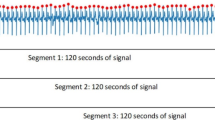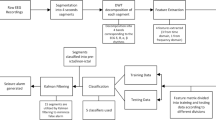Abstract
Epilepsy is a neurological disorder characterized by recurrent seizures due to abnormal discharges in cortical networks of the brain. A seizure prediction method with a low false-positive rate in a high confidence interval and without side effects may improve patients’ quality of life. Heart rate variability (HRV) analysis is among the most promising approaches for seizure prediction. This method indirectly assesses the behavior of the autonomic nervous system (ANS) through cardiac rhythm activity. Artificial intelligence (AI) classifiers may predict seizures and distinguish the different phases in ECG signals. This work evaluated several classifiers for seizure prediction and studied them in terms of computational cost for training, sensitivity, accuracy, false-positive rate (FPR), and their suitability for wearable applications using the HRV approach. Relied on the results, the Support Vector Classifier (SVC) obtained the best set of scores, including the highest accuracy, 97.57%, as well as the second-highest Sen, Spe, and NPV scores, 97.70%, 97.51%, and 98.83%, respectively for preictal periods, considering an evaluation of 14.08 h from six patients’ ECG data.
Access this chapter
Tax calculation will be finalised at checkout
Purchases are for personal use only
Similar content being viewed by others
References
World Health Organization: Epilepsy. https://www.who.int/en/news-room/fact-sheets/detail/epilepsy. Accessed 25 Apr 2022
Jeppesen, J., Beniczky, S., Johansen, P., Sidenius, P., Fuglsang-Frederiksen, A.: Detection of epileptic seizures with a modified heart rate variability algorithm based on Lorenz plot. Seizure 24, 1–7 (2015). https://doi.org/10.1016/j.seizure.2014.11.004
Melo, H., et al.: Ultra-short heart rate variability reliability for cardiac autonomic tone assessment in mesial temporal lobe epilepsy. Epilepsy Res. 174, 106662 (2021). https://doi.org/10.1016/j.eplepsyres.2021.106662
Truong, N.D., et al.: Seizure susceptibility prediction in uncontrolled epilepsy. Front. Neurol. 12 (2021). https://doi.org/10.3389/fneur.2021.721491. https://www.frontiersin.org/article/10.3389/fneur.2021.721491. ISSN 1664-2295
Pavei, J., et al.: Early seizure detection based on cardiac autonomic regulation dynamics. Front. Physiol. 8 (2017). https://doi.org/10.3389/fphys.2017.00765. https://www.frontiersin.org/article/10.3389/fphys.2017.00765. ISSN 1664-042X
Bhattacharya, A., Baweja, T., Karri, S.P.K.: Epileptic seizure prediction using deep transformer model. Int. J. Neural Syst. 32(02), 2150058 (2022). https://doi.org/10.1142/S0129065721500581. PMID 34720065
Jacobs, D., Hilton, T., del Campo, M., Carlen, P.L., Bardakjian, B.L.: Classification of pre-clinical seizure states using scalp EEG cross-frequency coupling features. IEEE Trans. Biomed. Eng. 65(11), 2440–2449 (2018). https://doi.org/10.1109/TBME.2018.2797919
Dono, F., et al.: Interictal heart rate variability analysis reveals lateralization of cardiac autonomic control in temporal lobe epilepsy. Front. Neurol. 11 (2020). https://doi.org/10.3389/fneur.2020.00842. https://www.frontiersin.org/article/10.3389/fneur.2020.00842. ISSN 1664-2295
Faria, T., et al.: Does the type of seizure influence heart rate variability changes? Epilepsy Behav. 126, 108453 (2022). https://doi.org/10.1016/j.yebeh.2021.108453
Shasha, Z., Chen, D., Ranjan, R., Heng**, K., Tang, Y., Zomaya, A.: A lightweight solution to epileptic seizure prediction based on EEG synchronization measurement. J. Supercomput. 77, 1–19 (2021). https://doi.org/10.1007/s11227-020-03426-4
Abdelhameed, A., Bayoumi, M.: A deep learning approach for automatic seizure detection in children with epilepsy. Front. Comput. Neurosci. 15 (2021). https://doi.org/10.3389/fncom.2021.650050. https://www.frontiersin.org/article/10.3389/fncom.2021.650050. ISSN 1662-5188
Xu, Y., Yang, J., Zhao, S., Wu, H., Sawan, M.: An end-to-end deep learning approach for epileptic seizure prediction. In: 2020 2nd IEEE International Conference on Artificial Intelligence Circuits and Systems (AICAS), pp. 266–270 (2020). https://doi.org/10.1109/AICAS48895.2020.9073988
Selim, S., Elhinamy, E., Othman, H., Abouelsaadat, W., Salem, M.A.-M.: A review of machine learning approaches for epileptic seizure prediction. In: 2019 14th International Conference on Computer Engineering and Systems (ICCES), pp. 239–244 (2019). https://doi.org/10.1109/ICCES48960.2019.9068190
Burguera, A.: Using machine learning and heart rate variability features to predict epileptic seizures, October 2019
Silva, R.S., Plantes Neto, A.R., Brum Marques, J.L., Kavehei, O., Rodrigues, C.R.: A compact QRS detection system based on 0.79 W analog CMOS energy-of-derivative circuit. Microelectron. J. 113, 105097 (2021). https://doi.org/10.1016/j.mejo.2021.105097. https://www.sciencedirect.com/science/article/pii/S0026269221001087. ISSN 0026-2692
Gadhoumi, K., Lina, J.-M., Gotman, J.: Seizure prediction in patients with mesial temporal lobe epilepsy using EEG measures of state similarity. Clin. Neurophysiol. Off. J. Int. Feder. Clin. Neurophysiol. 124 (2013). https://doi.org/10.1016/j.clinph.2013.04.006
Chen, H.-H., Cherkassky, V.: Performance metrics for online seizure prediction. Neural Netw. 128, 22–32 (2020). https://doi.org/10.1016/j.neunet.2020.04.022. https://www.sciencedirect.com/science/article/pii/S0893608020301428. ISSN 0893-6080
Goldberger, A.L., et al.: PhysioBank, PhysioToolkit, and PhysioNet. Circulation 101(23), e215–e220 (2000). https://doi.org/10.1161/01.CIR.101.23.e215. https://www.ahajournals.org/doi/abs/10.1161/01.CIR.101.23.e215
Detti, P., Vatti, G., de Lara, G.Z.M.: EEG synchronization analysis for seizure prediction: a study on data of noninvasive recordings. Processes 8(7) (2020). https://doi.org/10.3390/pr8070846. https://www.mdpi.com/2227-9717/8/7/846. ISSN 2227-9717
Höller, Y., Trinka, E., Kalss, G., Schiepek, G., Michaelis, R.: Correlation of EEG spectra, connectivity, and information theoretical biomarkers with psychological states in the epilepsy monitoring unit - a pilot study. Epilepsy Behav. 99 (2019). https://doi.org/10.1016/j.yebeh.2019.106485. https://www.epilepsybehavior.com/article/S1525-5050(19)30470-6/fulltext
Romigi, A., et al.: Heart rate variability parameters during psychogenic non-epileptic seizures: comparison between patients with pure PNES and comorbid epilepsy. Front. Neurol. 11 (2020). https://doi.org/10.3389/fneur.2020.00713. https://www.frontiersin.org/article/10.3389/fneur.2020.00713. ISSN 1664-2295
Shaffer, F., Ginsberg, J.P.: An overview of heart rate variability metrics and norms. Front. Public Health 5 (2017). https://doi.org/10.3389/fpubh.2017.00258. https://www.frontiersin.org/article/10.3389/fpubh.2017.00258. ISSN 2296-2565
Pedregosa, F., et al.: Scikit-learn: machine learning in Python. J. Mach. Learn. Res. 12, 2825–2830 (2011)
Schölkopf, B., Smola, A., Müller, K.-R.: Nonlinear component analysis as a kernel eigenvalue problem. Neural Comput. 10(5), 1299–1319 (1998). https://doi.org/10.1162/089976698300017467
Acknowledgments
The authors are grateful to the Brazilian agencies CAPES, CNPq, and CAPES-UFSC PrInt for supporting this work.
Author information
Authors and Affiliations
Corresponding author
Editor information
Editors and Affiliations
Ethics declarations
Conflict of Interest
The authors declare that they have no conflict of interest.
Rights and permissions
Copyright information
© 2024 The Author(s), under exclusive license to Springer Nature Switzerland AG
About this paper
Cite this paper
Silva, R.S., Rodrigues, C.R., Walz, R., Marques, J.L.B. (2024). A Comparison of Classifiers for Epileptic Seizure Prediction Based on Heart Rate Variability. In: Marques, J.L.B., Rodrigues, C.R., Suzuki, D.O.H., Marino Neto, J., García Ojeda, R. (eds) IX Latin American Congress on Biomedical Engineering and XXVIII Brazilian Congress on Biomedical Engineering. CLAIB CBEB 2022 2022. IFMBE Proceedings, vol 99. Springer, Cham. https://doi.org/10.1007/978-3-031-49404-8_23
Download citation
DOI: https://doi.org/10.1007/978-3-031-49404-8_23
Published:
Publisher Name: Springer, Cham
Print ISBN: 978-3-031-49403-1
Online ISBN: 978-3-031-49404-8
eBook Packages: EngineeringEngineering (R0)




